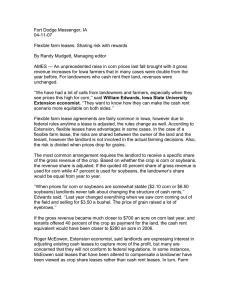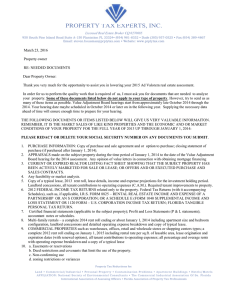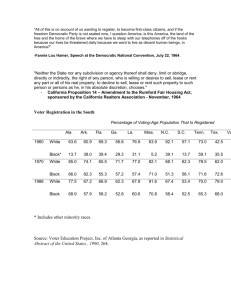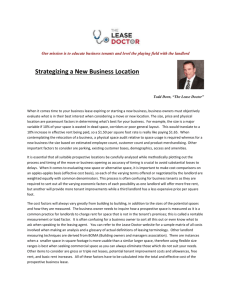Fort Dodge Messenger, IA 04-14-07 Landowners seek equitable rate for rented lands
advertisement
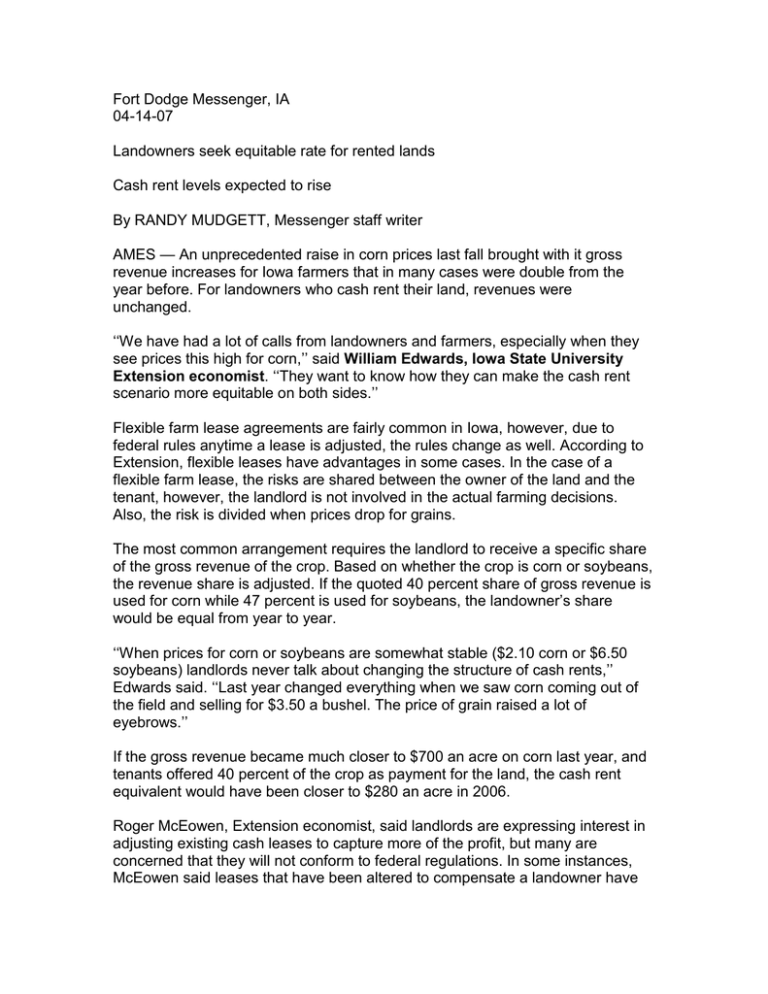
Fort Dodge Messenger, IA 04-14-07 Landowners seek equitable rate for rented lands Cash rent levels expected to rise By RANDY MUDGETT, Messenger staff writer AMES — An unprecedented raise in corn prices last fall brought with it gross revenue increases for Iowa farmers that in many cases were double from the year before. For landowners who cash rent their land, revenues were unchanged. ‘‘We have had a lot of calls from landowners and farmers, especially when they see prices this high for corn,’’ said William Edwards, Iowa State University Extension economist. ‘‘They want to know how they can make the cash rent scenario more equitable on both sides.’’ Flexible farm lease agreements are fairly common in Iowa, however, due to federal rules anytime a lease is adjusted, the rules change as well. According to Extension, flexible leases have advantages in some cases. In the case of a flexible farm lease, the risks are shared between the owner of the land and the tenant, however, the landlord is not involved in the actual farming decisions. Also, the risk is divided when prices drop for grains. The most common arrangement requires the landlord to receive a specific share of the gross revenue of the crop. Based on whether the crop is corn or soybeans, the revenue share is adjusted. If the quoted 40 percent share of gross revenue is used for corn while 47 percent is used for soybeans, the landowner’s share would be equal from year to year. ‘‘When prices for corn or soybeans are somewhat stable ($2.10 corn or $6.50 soybeans) landlords never talk about changing the structure of cash rents,’’ Edwards said. ‘‘Last year changed everything when we saw corn coming out of the field and selling for $3.50 a bushel. The price of grain raised a lot of eyebrows.’’ If the gross revenue became much closer to $700 an acre on corn last year, and tenants offered 40 percent of the crop as payment for the land, the cash rent equivalent would have been closer to $280 an acre in 2006. Roger McEowen, Extension economist, said landlords are expressing interest in adjusting existing cash leases to capture more of the profit, but many are concerned that they will not conform to federal regulations. In some instances, McEowen said leases that have been altered to compensate a landowner have been viewed as crop share leases rather than cash rent leases. In turn, Farm Service Agency rules dictate that tenants must repay the direct payments to the government. ‘‘Under Farm Service Agency regulations, if a lease is a cash lease, the tenant is entitled to the government payments (direct farm payments). For share leases, the payments are split according to the crop share lease,’’ McEowen said. While the majority of Iowa farmland is rented on a cash basis, McEowen said tenants can benefit from the adjustable cash rent scenario, especially if the tenant is worried about payment limitations. ‘‘Being a cash rent tenant may not always work to their advantage,’’ he said. ‘‘Government subsidies are also gained through loan deficiency payments and marketing loan gains. These benefits represent the difference between the average world price of the commodity and the market price as determined by USDA and count against the producer’s $75,000 payment limitation for all commodities. So, in a cash rent situation, the entire subsidy counts against the tenant’s payment limitation. A cash rent tenant could end up leaving a lot of subsidy payments on the table that could have been counted against a separate payment limit for the landlord.’’ One type of lease, according to Edwards, is the base rent plus bonus scenario. In this lease, cash rent is often set lower, then, when revenues exceed a certain level agreed upon by the owner and tenant, the revenue is shared. For example, if the price for soybeans is $5 a bushel and the farmer harvests a 50 bushel per acre crop, the gross revenue would be $250 or the base level for sharing revenue. Once the price increases to say $7 a bushel, the revenue increases to $350. In this scenario, the landlord would gain $50 per acre plus the base rent of $100, an equitable exchange for the crop. ‘‘Right now, there have been a lot of calls about shifting to a flexible farm lease system,’’ Edwards said. ‘‘It is really between the landlord and the tenant on how best to go forward with this system.’’ McEowen recommends discussing any changes in existing leases with Farm Service Agency representatives before making changes. ‘‘The FSA gets pretty concerned about these cash rent provisions. They could take the position that the lease is a share lease even though the lease is labeled a cash lease, so make sure the lease complies with FSA rules.’’
